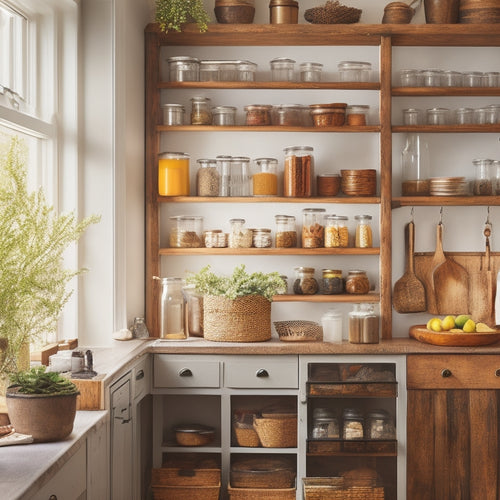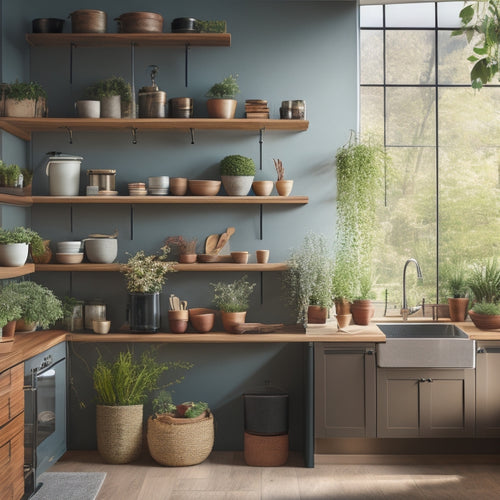
What Makes a Kitchen Senior-Friendly for Arthritis?
Share
You can create a kitchen that's gentle on your arthritis by incorporating features that reduce strain and discomfort. Start with user-friendly faucets and sinks that are easy to operate, and adjustable countertops that keep frequently used items within reach. Guarantee ample clearance and space to move around easily, and opt for simple-to-operate appliances and utensils with comfortable grips. Task-oriented lighting design and slip-resistant floor surfaces can also make a big difference. Add comfortable seating options, easy-to-grip cabinet handles, and adaptive storage solutions to complete your senior-friendly kitchen. By incorporating these features, you'll be well on your way to creating a kitchen that works with you, not against you, and discover more ways to customize your space to your needs.
Key Takeaways
• A senior-friendly kitchen for arthritis incorporates user-friendly faucets, sinks, and appliances with ergonomic designs to reduce strain on joints.
• Accessible countertop heights, ample clearance, and space enable easy movement and navigation, minimizing obstacles and fall risks.
• Task-oriented lighting design with maximized natural light, dimmer switches, and focused task lighting reduces eye strain and improves visibility.
• Adaptive storage solutions, easy-to-grip cabinet handles, and comfortable seating options promote independence and reduce discomfort.
• Slip-resistant floor surfaces, non-slip rugs, and textured flooring provide traction and stability, reducing the risk of falls and injuries.
Easy-to-Use Faucets and Sinks
When living with arthritis, simple tasks like washing dishes or brushing teeth can become challenging hurdles, but installing user-friendly faucets and sinks can make a significant difference in your daily routine. You'll appreciate the additional comfort and independence that comes with being able to navigate your kitchen with ease.
Look for faucets with ergonomic handles that fit snugly in your hand, reducing strain on your joints. An accessible design guarantees that you can effortlessly turn the faucet on and off, even with limited dexterity.
Functional faucets and convenient sinks can also make a big impact. Consider installing a faucet with a single-handle operation or a touchless model that responds to hand movements. This eliminates the need to grip or twist, making it easier to control water temperature and flow.
Additionally, sinks with shallow basins and ample space underneath allow for comfortable standing and movement. By incorporating these features into your kitchen, you'll be able to tackle daily tasks with confidence and minimal discomfort.
Accessible Countertop Heights
As you navigate your kitchen, you'll find that countertops that are tailored to your needs can greatly reduce strain on your joints and make meal preparation a more enjoyable experience. Adjustable surfaces and ergonomic design can make a significant difference in reducing fatigue and discomfort.
Here are some key considerations to keep in mind when designing your senior-friendly kitchen:
-
Counter heights: Opt for adjustable surfaces that can be customized to your ideal working height, reducing the need for bending or straining.
-
Ergonomic layout: Position frequently used items and appliances within easy reach to minimize stretching and straining.
-
Customizable options: Incorporate features like pull-out countertops or adjustable shelves to accommodate your changing needs.
- Functional workflow: Design your kitchen to flow smoothly, with clear paths and minimal obstacles, to reduce fatigue and frustration.
Ample Clearance and Space
Adequate space and room around your kitchen island, countertops, and appliances is vital for effortless movement, allowing you to navigate your kitchen with confidence and independence. A functional layout guarantees that you can easily move around without obstruction, reducing the risk of tripping or straining yourself. With ample space, you can use mobility aids like walkers or canes without feeling restricted or claustrophobic. This is especially important if you rely on these aids to get around.
When designing your kitchen, consider leaving at least 3-4 feet of space between countertops, appliances, and islands. This will give you enough room to move around comfortably, even with mobility aids.
Additionally, consider the 'work triangle' concept, where your sink, stove, and refrigerator form the points of a triangle. This layout helps reduce walking distances and makes it easier to move between tasks.
Simple-to-Operate Appliances
You'll appreciate the ease of using appliances that don't exacerbate your arthritis symptoms, especially when you're already struggling with mobility and dexterity in your kitchen. Simple-to-operate appliances can make a significant difference in your cooking experience. Look for features like large buttons, easy-grip handles, and lightweight designs that reduce strain on your joints.
Here are some must-haves for a senior-friendly kitchen:
-
Ergonomic cookware options: Choose pots and pans with comfortable, cushioned handles that fit securely in your hand, reducing fatigue and strain.
-
User-friendly utensils: Opt for utensils with oversized grips, angled handles, or adaptive designs that make it easier to hold and maneuver.
-
Adaptive kitchen gadgets: Invest in gadgets like automatic can openers, one-touch jar openers, and easy-turn handles that simplify kitchen tasks.
- Arthritis-friendly tools: Consider tools with built-in grips or assistive devices, such as rocker knives or ergonomic peelers, that reduce the effort required for common tasks.
Task-Oriented Lighting Design
How can you guarantee that your kitchen lighting is working for you, not against you, when arthritis symptoms like fatigue and sensitivity to glare are already making cooking more challenging? A well-designed lighting plan can make all the difference.
Start by maximizing natural light, which can help reduce eye strain and improve visibility. If possible, position your kitchen near a window or install skylights to bring in more natural light.
Next, consider installing dimmer switches, which allow you to adjust the light levels to suit your needs. This can be especially helpful if you're sensitive to glare or experience eye fatigue.
Task lighting is also essential, as it helps illuminate specific areas where you'll be performing tasks, such as cooking or food prep. Installing under-cabinet lighting, for example, can provide focused lighting exactly where you need it, reducing the need for overhead lighting that can be harsh.
Slip-Resistant Floor Surfaces
As you're designing a kitchen that accommodates your arthritis, it's just as important to ponder the floor beneath your feet as it's to contemplate the lighting above your head. A slip-resistant floor surface can be a game-changer for seniors with arthritis, reducing the risk of falls and making mobility easier.
Here are some essential features to keep in mind:
-
Non-slip rugs: Place them strategically in areas prone to moisture, such as near the sink or stove, to provide extra grip.
-
Floor cushions: Keep in mind installing them at entrance points to reduce the impact of a potential fall.
-
Textured flooring: Choose flooring materials with textured surfaces, like ceramic or porcelain tiles, to improve traction.
- Easier cleaning: Opt for flooring that's easy to clean and maintain, reducing the risk of slipping on spills or messes.
Comfortable Seating Options
When designing a senior-friendly kitchen, incorporating comfortable seating options can be an important aspect of reducing fatigue and discomfort associated with arthritis, allowing you to take breaks and rest while still being part of the cooking process.
As you navigate your kitchen, it's essential to have a place to sit and recharge. Adjustable stools or reclining chairs can be a great addition, providing the flexibility to adjust to your comfort level.
These seating options can be especially helpful when you need to take a break from standing or cooking. Additionally, consider incorporating supportive cushions or ergonomic benches into your kitchen design. These features can help alleviate pressure points and provide extra comfort while you're sitting.
By incorporating these comfortable seating options, you'll be able to rest and recharge, reducing the strain on your joints and muscles. This, in turn, can help you maintain your independence and confidence in the kitchen.
With the right seating options, you'll be able to enjoy cooking and socializing with family and friends without the burden of discomfort.
Easy-to-Grip Cabinet Handles
You'll appreciate the convenience of easy-to-grip cabinet handles, which eliminate the strain of grasping small or slippery knobs, especially on days when arthritis symptoms are more pronounced. These handles are designed to provide a comfortable grip, reducing the effort required to open cabinets and drawers. This is particularly important in the kitchen, where you may need to access cooking utensils, ingredients, or cleaning supplies frequently.
Here are some benefits of easy-to-grip cabinet handles:
-
Reduced strain: Easy-to-grip handles reduce the strain on your hands, wrists, and fingers, making it easier to open cabinets and drawers.
-
Improved accessibility: These handles provide a secure grip, allowing you to access kitchen essentials with confidence, even on days when arthritis symptoms are more pronounced.
-
Compatibility with other senior-friendly features: Easy-to-grip cabinet handles complement other senior-friendly features, such as levered faucets and drawer organizers, to create a kitchen that's easy to navigate.
- Aesthetically pleasing: These handles come in a variety of styles and finishes, ensuring that your kitchen remains visually appealing while prioritizing functionality and safety.
Adaptive Storage Solutions
Optimize your kitchen's storage capacity with adaptive solutions that keep frequently used items within easy reach, reducing the need to stretch, bend, or strain your joints. This not only saves energy but also reduces the risk of injury or discomfort.
Consider incorporating ergonomic shelving and adjustable compartments to create a personalized storage system. These features allow you to customize your storage space according to your needs, ensuring that everything is within comfortable reach.
Here are some examples of adaptive storage solutions you can implement:
| Storage Solution | Benefits |
|---|---|
| Pull-out shelves | Reduces bending and straining |
| Adjustable cabinet shelves | Accommodates items of varying sizes |
| Drawer organizers | Keeps frequently used items within easy reach |
| Lazy susans | Eliminates the need to reach or bend |
Frequently Asked Questions
Can Senior-Friendly Kitchens Be Designed for Other Mobility Issues Too?
You can create a kitchen that's accessible to everyone by incorporating universal design principles and accessibility improvements, allowing you to accommodate various mobility issues, from arthritis to wheelchair use, and ensuring a safe, comfortable space for all.
How Much Does It Cost to Renovate a Kitchen for Senior-Friendliness?
You're wisely considering the cost of renovating your kitchen for senior-friendliness, which can range from $10,000 to $50,000, depending on DIY vs professional renovation and financing options, like home equity loans or grants, that can help make it more affordable.
Are There Any Specific Kitchen Layouts That Work Best for Seniors?
Did you know that 80% of seniors prefer aging in place? You'll want to think about an ergonomic design that creates functional space, allowing you to move comfortably and safely, with ample room for mobility aids, if needed.
Can I Still Have a Stylish Kitchen That's Senior-Friendly?
You can absolutely have a stylish kitchen that's senior-friendly! Focus on stylish functionality, prioritizing ease of use and comfort, to create a space that supports aging in place while maintaining your personal style.
Are There Any Government Incentives for Senior-Friendly Kitchen Renovations?
You're likely wondering if you can get some financial help for your senior-friendly kitchen renovation. Yes, you might be eligible for tax credits and grants for accessibility modifications, such as installing grab bars or non-slip flooring.
Related Posts
-

Creative Organization Ideas for Tight Kitchen Spaces
To create an organized kitchen in tight spaces, think upwards. Install shelves that reach the ceiling and use wall-mo...
-

Easy-To-Install Kitchen Wall-Mounted Racks
Installing easy-to-use kitchen wall-mounted racks is a smart way to maximize your space. These racks help keep your c...
-

Freestanding Pantry Units for Farmhouse Kitchen Style
Freestanding pantry units perfectly blend beauty and function in your farmhouse kitchen. They maximize storage while ...


